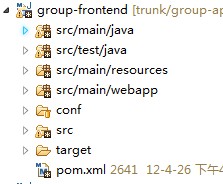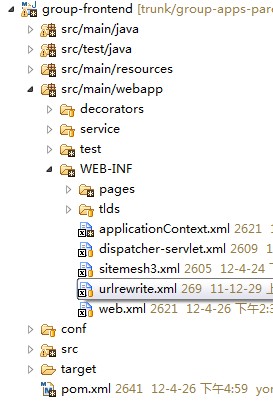Spring Junit 读取WEB-INF下的配置文件
2016-08-02 12:19
531 查看
假设Spring配置文件为applicationContext.xml
一、Spring配置文件在类路径下面
在Spring的java应用程序中,一般我们的Spring的配置文件都是放在放在类路径下面(也即编译后会进入到classes目录下)。
以下是我的项目,因为是用maven管理的,所以配置文件都放在“src/main/resources”目录下

这时候,在代码中可以通过
[java]
view plain
copy
ApplicationContext applicationContext = new ClassPathXmlApplicationContext("applicationContext.xml");
然后获取相应的bean。
如果代码想用Junit测试框架来测试,则Spring提供了对Junit支持,还可以使用注解的方式:
[java]
view plain
copy
@RunWith(SpringJUnit4ClassRunner.class)
@ContextConfiguration(locations={"classpath:applicationContext.xml"})
只需要在相应的Test类前面加上此两个注解(第二个注解用来指明Spring的配置文件位置),就可以在Junit Test类使用中Spring提供的依赖注入功能。
二、Spring配置文件在WEB-INF下面
当然在做J2EE开发时,有些人习惯把Spring文件放在WEB-INF目录(虽然更多人习惯放在类路径下面)下面;或者有些Spring配置文件是放在类路径下面,而有些又放在
WEB-INF目录下面,如下图。

这时候,在代码中就不可以使用ClassPathXmlApplicationContext来加载配置文件了,而应使用FileSystemXmlApplicationContext。
[java]
view plain
copy
ApplicationContext applicationContext = new FileSystemXmlApplicationContext("src/main/webapp/WEB-INF/applicationContext.xml");
然后获取相应的bean。
如果代码想用Junit测试框架来测试,则Spring提供了对Junit支持,还可以使用注解的方式:
[java]
view plain
copy
@RunWith(SpringJUnit4ClassRunner.class)
@ContextConfiguration(locations={"file:src/main/webapp/WEB-INF/applicationContext.xml"})
只需要在相应的Test类前面加上此两个注解(第二个注解用来指明Spring的配置文件位置),就可以在Junit Test类使用中Spring提供的依赖注入功能。
下面是我的一个Spring管理下的Junit测试类:
[java]
view plain
copy
package com.sohu.group.service.external;
import java.util.List;
import org.junit.Test;
import org.junit.runner.RunWith;
import org.springframework.beans.factory.annotation.Autowired;
import org.springframework.test.context.ContextConfiguration;
import org.springframework.test.context.junit4.SpringJUnit4ClassRunner;
@RunWith(SpringJUnit4ClassRunner.class)
@ContextConfiguration({"file:src/main/webapp/WEB-INF/applicationContext.xml"})
public class SuFriendServiceImplOverRMITest {
@Autowired
private SuFriendService suFriendService;
@Test
public void getUserFollowerListTest(){
List<String> list = suFriendService.getUserFollowerList("liug_talk@163.com");
System.out.println("------"+list);
}
}
@RunWith(SpringJUnit4ClassRunner.class)
@ContextConfiguration(locations={"file:WebContent/WEB-INF/config/spring/*applicationContext*.xml","file:WebContent/WEB-INF/config/*.xml"})
public class TestLoadSpring {
@Autowired
private SaleService saleService;
@Test
public void listSales(){
List<SaleVo> listSales=saleService.list(new HashMap(), "", 1, 10, true);
for(SaleVo vo:listSales){
System.out.println(JSONObject.toJSON(vo));
}
}
}
一、Spring配置文件在类路径下面
在Spring的java应用程序中,一般我们的Spring的配置文件都是放在放在类路径下面(也即编译后会进入到classes目录下)。
以下是我的项目,因为是用maven管理的,所以配置文件都放在“src/main/resources”目录下

这时候,在代码中可以通过
[java]
view plain
copy
ApplicationContext applicationContext = new ClassPathXmlApplicationContext("applicationContext.xml");
然后获取相应的bean。
如果代码想用Junit测试框架来测试,则Spring提供了对Junit支持,还可以使用注解的方式:
[java]
view plain
copy
@RunWith(SpringJUnit4ClassRunner.class)
@ContextConfiguration(locations={"classpath:applicationContext.xml"})
只需要在相应的Test类前面加上此两个注解(第二个注解用来指明Spring的配置文件位置),就可以在Junit Test类使用中Spring提供的依赖注入功能。
二、Spring配置文件在WEB-INF下面
当然在做J2EE开发时,有些人习惯把Spring文件放在WEB-INF目录(虽然更多人习惯放在类路径下面)下面;或者有些Spring配置文件是放在类路径下面,而有些又放在
WEB-INF目录下面,如下图。

这时候,在代码中就不可以使用ClassPathXmlApplicationContext来加载配置文件了,而应使用FileSystemXmlApplicationContext。
[java]
view plain
copy
ApplicationContext applicationContext = new FileSystemXmlApplicationContext("src/main/webapp/WEB-INF/applicationContext.xml");
然后获取相应的bean。
如果代码想用Junit测试框架来测试,则Spring提供了对Junit支持,还可以使用注解的方式:
[java]
view plain
copy
@RunWith(SpringJUnit4ClassRunner.class)
@ContextConfiguration(locations={"file:src/main/webapp/WEB-INF/applicationContext.xml"})
只需要在相应的Test类前面加上此两个注解(第二个注解用来指明Spring的配置文件位置),就可以在Junit Test类使用中Spring提供的依赖注入功能。
下面是我的一个Spring管理下的Junit测试类:
[java]
view plain
copy
package com.sohu.group.service.external;
import java.util.List;
import org.junit.Test;
import org.junit.runner.RunWith;
import org.springframework.beans.factory.annotation.Autowired;
import org.springframework.test.context.ContextConfiguration;
import org.springframework.test.context.junit4.SpringJUnit4ClassRunner;
@RunWith(SpringJUnit4ClassRunner.class)
@ContextConfiguration({"file:src/main/webapp/WEB-INF/applicationContext.xml"})
public class SuFriendServiceImplOverRMITest {
@Autowired
private SuFriendService suFriendService;
@Test
public void getUserFollowerListTest(){
List<String> list = suFriendService.getUserFollowerList("liug_talk@163.com");
System.out.println("------"+list);
}
}
@RunWith(SpringJUnit4ClassRunner.class)
@ContextConfiguration(locations={"file:WebContent/WEB-INF/config/spring/*applicationContext*.xml","file:WebContent/WEB-INF/config/*.xml"})
public class TestLoadSpring {
@Autowired
private SaleService saleService;
@Test
public void listSales(){
List<SaleVo> listSales=saleService.list(new HashMap(), "", 1, 10, true);
for(SaleVo vo:listSales){
System.out.println(JSONObject.toJSON(vo));
}
}
}
相关文章推荐
- Junit单元测试Spring 读取WEB-INF下的配置文件
- Junit单元测试Spring 读取WEB-INF下的配置文件
- Spring Junit 读取WEB-INF下的配置文件
- Spring+Junit 读取WEB-INF上的配置文件
- Spring Junit 读取WEB-INF下的配置文件
- Spring Junit 读取WEB-INF下的配置文件
- Spring Junit 读取WEB-INF下的配置文件
- Spring Junit 读取WEB-INF下的配置文件路径
- Spring+Junit 读取WEB-INF上的配置文件
- Spring Junit 读取WEB-INF下的配置文件
- Spring MVC Junit测试实例 附:读取WEB-INF下配置文件的方法
- java文件读取web-inf下的spring的xml配置文件
- Junit单元测试Spring读取classes或者WEB-INF目录下的配置文件
- 读取web-inf目录下的spring配置文件
- Junit 单元测试 Spring 读取WEB-INF下 xml 文件
- Spring 读取WEB-INF配置文件
- Spring MVC Junit测试实例 附:读取WEB-INF下配置文件的方法
- Spring MVC Junit测试实例 附:读取WEB-INF下配置文件的方法
- Spring MVC Junit测试实例 附:读取WEB-INF下配置文件的方法
- Spring 读取WEB-INF配置文件
